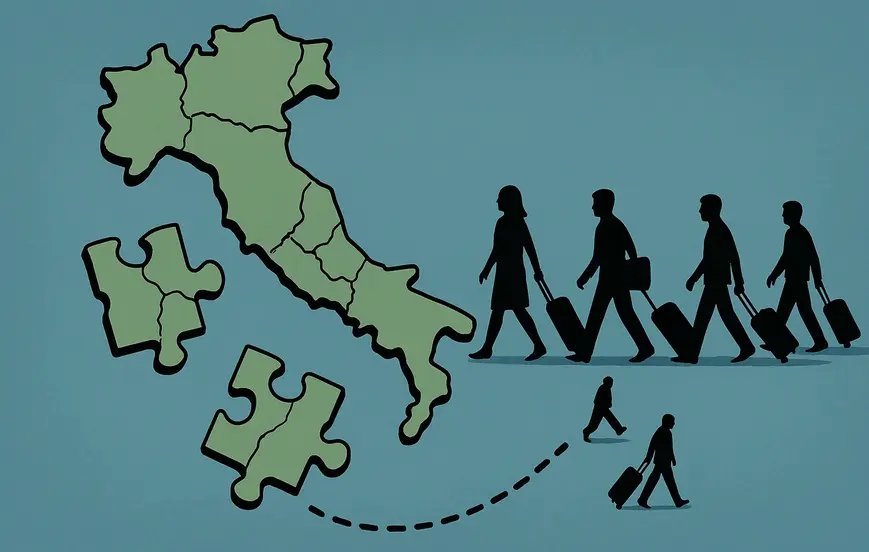Understanding Italy’s Massive Youth Exodus
Economic future concerns are growing rapidly in Italy as the country faces an alarming brain drain crisis. Over the past decade, more than one million Italians have left in search of better opportunities abroad. Alarmingly, a third of these emigrants are young professionals aged 25 to 34, Italy’s most educated and economically productive population segment. This loss of skilled talent poses a serious threat to the nation’s long-term economic future.
This exodus is accelerating, putting additional pressure on Italy’s economy – already the Eurozone’s third-largest – which struggles with a rapidly aging population. The trend briefly slowed during the post-Brexit period and COVID-19 pandemic but has since rebounded strongly, with 2023 marking the highest immigration level in 25 years.
The Scale of Italy’s Brain Drain Crisis
The statistics paint a troubling picture of Italy’s demographic challenge:
- Over 1 million Italians have emigrated in the past decade
- Approximately 191,000 Italians left the country last year alone
- About 35,000 long-term foreign residents returned to their countries of origin
- More than 132,000 university graduates have relocated to other European nations
Where Are Young Italians Going?
European Destinations Lead the Way
Europe remains the primary destination for Italian emigrants, with approximately 55% choosing to relocate within the continent. The most popular destinations include:
- United Kingdom
- Germany
- France
- Switzerland
- Spain
This pattern highlights how young Italians are seeking opportunities in countries with stronger economies and more competitive job markets. For those considering international career moves, WhatJobs international opportunities offers resources for job seekers looking beyond their home countries.

The Latin American Connection
Interestingly, there has also been a rise in immigration to Latin American countries, particularly among foreign-born Italian citizens. Many newly naturalized Italian citizens return to their birth countries in South America after gaining Italian citizenship, often staying in Italy just long enough to qualify for citizenship.
Root Causes of Italy’s Brain Drain Crisis
Economic Factors Driving Young Talent Away
The primary drivers behind Italy’s brain drain are economic. According to recent polling, 35% of Italians under 30 are willing to move abroad, citing three main reasons:
1. Stagnant Wages: Italy is the only EU country where real wages have declined since 1990, leaving many struggling with rising living costs. In 2022 alone, wages dropped 7.3% in real terms compared to the previous year.
2. Limited Job Opportunities: Italy has one of the EU’s highest youth unemployment rates. Young educated professionals often find themselves trapped in precarious employment with underpaid temporary contracts or part-time roles.
3. Lack of Meritocracy: Italian workplaces are widely perceived as favoring seniority over performance. Eight in ten young Italians believe too many older people occupy senior positions, and data shows workers under 35 earn just over half what their older colleagues make.
For those seeking more competitive employment options, WhatJobs career listings provides opportunities across various sectors and experience levels.
📢 Hire the Right Talent on WhatJobs
Need to fill a role fast? Reach thousands of skilled candidates actively looking for their next opportunity — in tech, engineering, business, and more.
Post your job on WhatJobs and connect with qualified professionals who are ready to make an impact.
👉 Post a Job NowItaly’s Unique Wage Structure
Unlike most EU countries, Italy lacks a statutory minimum wage. Instead, wages are set through collective bargaining agreements between unions and employer groups. While this system technically covers over 80% of workers, the absence of a legal wage floor means there’s no universal minimum protection.
This particularly affects:
- Part-time workers
- Interns
- Informal workers
- Young professionals
Weak enforcement has led to widespread wage theft and “gray work” (off-the-books or underpaid labor), especially among young people entering the workforce. For more information on Italy’s economic challenges, see the OECD Italy Economic Survey and World Bank Italy Overview.
Economic Implications of Italy’s Brain Drain Crisis
The Cost of Lost Human Capital
The economic consequences of Italy’s brain drain are severe and far-reaching:
- The loss of human capital is estimated to have cost Italy €134 billion between 2011 and 2023
- Declining productivity due to the exodus of skilled professionals
- The Bank of Italy warns that the projected decline in working-age population could reduce GDP by up to 11% in coming years
Exacerbating Italy’s Demographic Crisis
Italy’s brain drain is worsening an already critical demographic situation:
- Italy’s fertility rate has remained below replacement level since 1976
- In 2022, fewer than 400,000 babies were born – the lowest number since Italian unification in 1861
- The country’s population has been shrinking since 2014
- Italy has the EU’s oldest population with a median age of 48
- The old-age dependency ratio is expected to rise to 0.66 in coming decades, meaning there will be only three working people for every two pensioners
Potential Solutions to Italy’s Brain Drain Crisis
Government Policy Approaches
To address Italy’s brain drain crisis, policymakers could consider:
- Implementing wage reforms to ensure competitive compensation for young professionals
- Creating tax incentives for companies that hire and retain young talent
- Investing in research and innovation to create high-quality job opportunities
- Reforming labor laws to reduce precarious employment
Immigration as a Solution?
Given Italy’s demographic challenges, increased immigration could help offset population decline and address workforce shortages. However, this remains politically contentious, with the current right-wing government taking steps to reduce immigration rather than encourage it.
For employers looking to connect with qualified candidates during these challenging times, post jobs for free with WhatJobs to reach talented professionals.
Need Career Advice?
Get employment skills advice for navigating international job markets
FAQ About Italy’s Brain Drain Crisis
What is causing Italy’s brain drain crisis?
Italy’s brain drain crisis is primarily driven by economic factors including stagnant wages, limited job opportunities, and lack of meritocracy in the workplace. Italy is the only EU country where real wages have declined since 1990, making it increasingly difficult for young professionals to build financially stable lives. This economic situation, combined with high youth unemployment and precarious work arrangements, pushes many talented Italians to seek opportunities abroad.
Which countries are most Italians emigrating to?
Most Italian emigrants (approximately 55%) choose European destinations, with the United Kingdom being the most popular, followed by Germany, France, Switzerland, and Spain. There’s also a growing trend of emigration to Latin American countries, particularly among foreign-born Italian citizens who return to their countries of birth after obtaining Italian citizenship. These destination choices reflect where Italians believe they can find better economic opportunities and career advancement.
How is Italy’s brain drain affecting its economy?
Italy’s brain drain is severely impacting its economy through the loss of human capital, estimated to have cost the country €134 billion between 2011 and 2023. The exodus of educated young professionals is driving down productivity and innovation potential. Additionally, with Italy’s aging population, the departure of working-age citizens is worsening the dependency ratio, with the Bank of Italy warning that the declining working-age population could reduce GDP by up to 11% in coming years.
What solutions could address Italy’s brain drain crisis?
Addressing Italy’s brain drain crisis requires comprehensive reforms including competitive wage structures, reduced employment precarity, and investment in sectors that create high-quality jobs. Establishing a statutory minimum wage could provide better protection for young workers currently vulnerable to exploitation. Additionally, policies that recognize merit and performance over seniority could help retain talented professionals. Immigration policies that welcome skilled workers could also help offset population decline and address workforce shortages in critical sectors.




